Flying Insects
Evergreen Pest Management can offer environmentally friendly pest control solutions for flying insect problems efficiently using the latest pest control processes. We service all areas from the Gold Coast to Northern NSW.

History.
Mosquitoes are blood sucking insects that are responsible for the transmission of many diseases throughout the human and animal populations of the world. Within Australia there are more than 300 different species of mosquito but only a small number are of major concern. Several important human diseases are transmitted throughout Australia by these insects including Dengue fever, Australian encephalitis, Ross River virus disease and Barmah Forerst virus disease; malaria has been transmitted locally in Australia only rarely in recent decades. In addition to being disease vectors, mosquitoes can cause major disruptions, through their persistent biting, to occupational, recreational and social activities.
Mosquitoes have six delicate legs and two wings covered in scales. The head of a mosquito is equipped with a projecting proboscis which conceals and protects the long piercing and sucking mouthparts. These biting insects have a complex life cycle; the immature stage is totally aquatic and the adult is terrestrial. The adult female returns to a water habitat for a brief period to lay each batch of eggs. Mosquito species vary in their breeding habits, biting behaviour, host preferences and flight range. Most mosquitoes disperse less than two kilometres; some move only a few metres away from their original breeding place, others can fly some 5 or 10 kilometres, and a few species will disperse up to 50 kilometres downwind from the larval habitats.
On average, a female mosquito will live 2-3 weeks, but the male’s lifespan is shorter. Within their lifetime both adult male and female will feed on nectar and plant fluids, but it is only the female that will seek a blood meal. The majority of species require this blood meal as a protein source for egg development. Female mosquitoes are attracted to a potential host through a combination of different stimuli that emanate from the host. The stimuli can include carbon dioxide, body odours, air movement or heat. Upon locating a suitable host, the female will probe the skin for a blood capillary then inject a small amount of saliva containing chemicals which prevent the host’s blood from clotting. This is often the pathway for potential pathogens such as viruses to enter a host. After engorging on the host’s blood the female will find a resting place to digest her meal and develop eggs before flying off to deposit them in a suitable aquatic habitat.
On hatching, the young larvae (wrigglers) feed continuously and grow through four different instars or moults. Larval development is dependent on the availability of food and prevailing conditions, particularly temperature, but generally takes at least one to two weeks. The final larval instar develops into an active comma-shaped pupa (tumbler) from which the adult mosquito emerges about 2 days later to feed, mate and develop eggs for the next generation.
Stop mosquitoes breeding around your home.
Mosquitoes breed in still water. The following are examples of potential breeding sites and control strategies that you can use around the home:
- Dispose of all tins, tyres and other rubbish containers that may hold water.
- Put sand around bases of pot plants to absorb excess water in the dish.
- Keep swimming pools chlorinated, salted or empty them completely when not in use for considerable periods.
- Empty children’s wading pools regularly.
- Overturn boats and dinghies or remove the drain plug so they do not hold water.
- Empty flower vases, pot plants and other receptacles that hold water at least once a week.
- Drill holes in tyres used for swings, playgrounds and garden surrounds to allow water to drain.
- Empty bird baths and pets’ drinking water at least once a week.
- Prevent leaking taps which can maintain semipermanent pools.
- Flush disused outside toilets once a week.
- Keep fish ponds stocked with fish.
- Remove weeds and grass from drains to enable them to drain freely.
- Keep roof guttering in good repair and regularly remove leaves and debris so that pools of water do not form.
- Keep lawns and gardens well maintained so that you are not providing shelter for adult mosquitoes.
History.
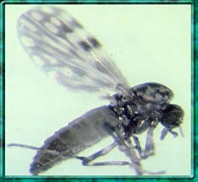 Biting midges are small robust insects with piercing and sucking mouthparts that belong to the family of flies. Only a few groups within this family are known to suck blood and their distribution is almost world wide. These small flies are renowned for their nuisance biting associated with habitats such as coastal lagoons, estuaries, mangrove swamps and tidal flats. In Australia these flies are commonly known as sandflies but are correctly referred to as biting midges.
Biting midges are small robust insects with piercing and sucking mouthparts that belong to the family of flies. Only a few groups within this family are known to suck blood and their distribution is almost world wide. These small flies are renowned for their nuisance biting associated with habitats such as coastal lagoons, estuaries, mangrove swamps and tidal flats. In Australia these flies are commonly known as sandflies but are correctly referred to as biting midges.
The biting activity of adult biting midges is mainly limited to the periods of dawn and dusk; they will remain inactive through very windy weather, finding shelter amongst vegetation.
Biting midges will usually disperse only short distances from their breeding sites. Only female midges feed on blood, but both the females and males will feed on vegetable fluids and nectar. Adults midges are 1.5-4.0 mm long with stout short legs, and at rest fold their wings, which are often mottled, over the abdomen. Their mouthparts are short and projected down.
Female midges may attack humans in large numbers, biting on any areas of exposed skin, and often on the face, scalp and hands. Some species will blood feed on a wide range of animal hosts. The egg batches contain between 30-100 eggs, and are laid on selected substrates such as mud, decaying leaf litter, damp soil or other vegetative materials, dependent on the species. The small eel-like larvae hatch in a few days; their larval habitat must contain a proportion of organic material with a high moisture content to provide optimum conditions for the larval stage to thrive and pupate. The whole life cycle takes 3-10 weeks, dependent on species and environmental conditions, particularly temperature.
Reactions.
Biting midges are responsible for acute discomfort, irritation and severe local reactions. Itching may commence immediately after the bite, but often not for some hours later, and most individuals are unaware of being bitten at the time. Biting midges have their greatest impact on people arriving to an area or tourists. Local residents seem to build up some immunity to the biting. In some sensitive people, midges can produce persistent reactions that blister and weep serum from the site of each bite and these reactions may last for several days to weeks. Biting midges are not known to transmit any disease-causing pathogens to humans in Australia.
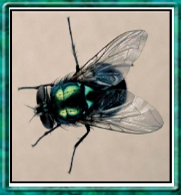
Life-cycle.
Blow flies are larger than the common house fly and they have a shiny metallic green, blue, or brown body.
The Australian Sheep Blowfly is an introduced pest. Its larvae normally feed on carcasses of dead animals but will also cause fly-strike in sheep. Fly-strike occurs when maggots feed on living flesh near open wounds, and is one of the most significant problems for the pastoral industry in Australia.
Adults are attracted to meat or living flesh and, like many blowflies they lay maggots rather than eggs. This means their full life cycle can sometimes be completed within seven days.
Distribution:
Throughout Australia.
Habitat:
Urban areas, semi-arid environments, forests and woodlands.
The normal habitat of Blow flies is outside. Females may enter houses in search of food unlike the common house fly they may frequent cool dark places such as larders and can be distinguished by their loud buzzing noise.
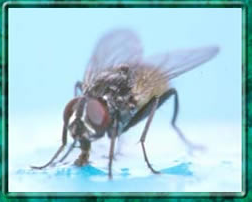 The House Fly is found all over the world, wherever there are human populations. Not only is it a nuisance, but it also carries disease-causing organisms, which it picks up from garbage and sewage.
The House Fly is found all over the world, wherever there are human populations. Not only is it a nuisance, but it also carries disease-causing organisms, which it picks up from garbage and sewage.
These flies are a common pest on cattle farms. They prefer to lay their eggs directly into rich organic matter such as cattle manure or fermenting plant material.
Adult flies probably only live for about a week under field conditions but in this time a female fly can lay some 500 eggs. Eggs are laid directly onto manure which accumulates in stables, where they hatch within a day or so.
Breeding conditions can also be found around buildings in places where manure has accumulated and remains moist for several days. The larvae (or maggots) have no legs and no distinct head. They feed on organic matter in manure throughout three larval stages, or instars. Between each instar they shed their old skin and produce a new one made of chitin. The manure has to have a high moisture content as larvae do not survive in dry manure.
Up to 10,000 flies can mature in just 1 kg of manure!
When fully grown the maggot will search for a drier location where it turns into a pupa. Such places are usually at the edge of the manure beds. Pupae are small, barrel shaped capsules about the size of a grain of rice.
A few days later an adult fly will emerge from the pupa. And the life cycle continues.
Distribution:
Throughout Australia and much of the rest of the world.
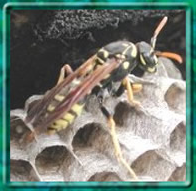
Native paper wasps are smaller than European Wasps, and lack their vivid yellow markings. They tend to only be aggressive when defending their nests, and are otherwise beneficial insects to have around the garden.
Identification.
Paper wasps have a small head, with medium sized eyes and medium length antennae. The body is slender, with a very narrow waist and the length is about 1-1.5cm. There are two pairs of brown-tinted wings, with the first pair larger. The abdomen has some yellow/orange bands, but is mainly black.
Habitat and Biology.
Paper wasps form small colonies, and make paper nests under tree branches and the eaves of houses. The nests are shaped like inverted cones, and consist of a cluster of hexagonal cells made from wood fibre mixed with saliva.
The wasp larvae are maggot-like and develop inside the papery cells of the nest. The adult wasps catch caterpillars to feed the larvae, but the adults themselves feed on nectar.
Recently, the introduced Asian Paper Wasp (Polistes chinensis) has been reported from several inner city suburbs of Sydney. This closely related species is larger than the native Polistes and tends to have more distinctive yellow and brown bands.
Toxicity.
These wasps can deliver painful stings, but are not as aggressive as European Wasps. They normally only attack humans if their nest is disturbed. If stings are multiple, a more severe systemic reaction may occur.
In some individuals, wasp, bee and ant stings can cause an allergic reaction.
First Aid.
A cold pack may be used to relieve the pain of the sting. If there is evidence of a more severe reaction or the sting victim is known to be allergic to wasp and bee venom, medical attention should be sought immediately.
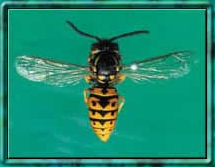
The European Wasp is easily distinguished from native wasps by its vivid yellow and black markings. It is a native of Europe, North Africa and Asia.
In Australia, the first European Wasps were found in Tasmania in 1959. By 1978 they had also been found in Victoria, South Australia, New South Wales and Western Australia. They are now firmly established in metropolitan Sydney, and are also found in Bowral / Moss Vale, the Blue Mountains, Narrandera, Deniliquin, Albury, Wagga, Coleambally, Griffith, Dareton, Junee, Forbes, Coonabarabran, Orange, Bathurst and West Wyalong. European Wasps are also present in New Zealand.
Identification.
European Wasps are a stout wasp with a bright yellow and black banded abdomen, and a pair of black spots on each yellow band. They have two pairs of clear wings with the first pair larger and the body is about 1.2 cm – 1.5 cm long. They have black antennae and fly with their legs held close to the body.
Habitat and Biology.
European Wasps are found in large communal nests, normally only visible as a small entrance hole. They are normally built either underground or in cavities in walls, ceilings, logs or trees. The nests are made from chewed wood fibre. Worker wasps leave the nest in search of food, and are attracted to meats, sweet food and drink.
Colonies begin in spring with a single fertilised queen, who makes a nest with a single egg in each of a small number of cells. These eggs hatch into grub-like larvae that are tended by the queen for the few weeks it takes them to reach maturity. This first batch of workers takes over nest construction and rearing larvae, and the queen concentrates on egg-laying. The nest continues to be extended throughout summer.
Towards the end of summer, several larger cells are constructed, in which a new generation of queens develop. Males also develop, and mate with the queens outside the nest before they die.
In late autumn the original queen dies, and the new queens disperse to find suitable sites before forming a new nest in spring. In Europe the old nest then disintegrates and the dispersed queens hibernate in sheltered spots beneath loose tree bark or in roofs.
A hibernating queen holds on to the substrate with her jaws, and tucks her legs, wings and antennae beneath her, remaining immobile for up to six months. However it is significant that in the warmer climate of Australia, one of the new queens may stay in the nest and begin laying eggs, without the usual over-wintering period being observed. Over several seasons, this can result in giant nests containing more than 100,000 wasps.
Toxicity.
European Wasps are more aggressive than bees and will attack when their nests are disturbed. Unlike bees, wasps can sting more than once, and do not die after stinging. The sting causes a burning pain and swelling. If stings are multiple, a more severe systemic reaction may occur.
First Aid.
A cold pack may be used to relieve the pain of the sting. If there is evidence of a more severe reaction or the sting victim is known to be allergic to wasp and bee venom, medical attention should be sought immediately.
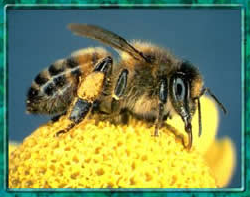 Australia’s early European settlers introduced Honey Bees to ensure a good supply of honey. Naturally a few escaped and they are now wild throughout most of Australia’s southern States. Honey Bees play an important role as pollinators of crops and wild flowers. But some wild flowers have suffered from the presence of Honey Bees as these flowers can only be pollinated by native bees. Some native bees use a special pollination technique required by certain flowers called buzz pollination. Honey Bees do not use this technique and remove pollen without pollinating the flowers. They are particularly attracted to clover flowers, so it is wise to be cautious if walking through clover patches. Like wasps, Honey Bees will vigorously defend their nests.
Australia’s early European settlers introduced Honey Bees to ensure a good supply of honey. Naturally a few escaped and they are now wild throughout most of Australia’s southern States. Honey Bees play an important role as pollinators of crops and wild flowers. But some wild flowers have suffered from the presence of Honey Bees as these flowers can only be pollinated by native bees. Some native bees use a special pollination technique required by certain flowers called buzz pollination. Honey Bees do not use this technique and remove pollen without pollinating the flowers. They are particularly attracted to clover flowers, so it is wise to be cautious if walking through clover patches. Like wasps, Honey Bees will vigorously defend their nests.
Honey Bee stings are barbed and, when a person is stung, the sting (with venom gland attached) will stick in the skin and tear away from the bee. This injury kills the bee, but the venom gland continues to pump venom through the sting, so it should be removed as soon as possible. Do not squeeze it as this will force more venom into the wound. The sting is best removed by scraping it out with a fingernail.
Most Honey Bee stings cause intense local pain and swelling. However, if a victim is allergic to bee venom, a sting may cause more general symptoms. Most seriously, these can include difficulty breathing and collapse. If a person is known to be allergic to bee venom, the sting should be removed and a pressure immobilisation bandage should be immediately applied. Seek medical attention.
Distribution:
Throughout Australia.
 Two species commonly infest homes – casemaking moths and webbing moths.
Two species commonly infest homes – casemaking moths and webbing moths.
Attack clothing, blankets, comforters, rugs, carpets, draperies, pillows, mattresses, brushes, upholstery, furs, piano felts and wool mixed with synthetic fibers.
Infest homes by finding their way into woolens improperly stored in dark places and left undisturbed for long periods of time.
Deposit soft white eggs in clothing and household furnishings. A single female is capable of depositing from 100 to 300 eggs.
Clothes moths.
Description: Casemaking clothes moths are 7–10mm long, are darker than Common clothes moths and have three dark spots on their wings. The larvae are up to 10mm long and are usually found in a case made from the material that they are feeding on. The colour of this case usually indicates what is being attacked.
They feed on wool, fur, hair, silk, dead insects, and feathers.
Control.
Keep rooms light and airy. Dry-clean material where necessary before storing in sealed plastic bags. Thorough, regular vacuuming helps to reduce its food sources. Thoroughly inspect and treat new acquisitions as necessary to prevent their introduction. Locate the source of the infestation. Arrange for the treatment of any infested artefacts by one of the low-toxic methods available.
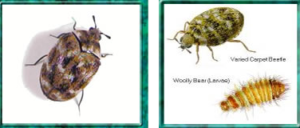
Adult carpet beetles are typically small (up to 5 mm long) and oval or elongate- oval in shape. Larvae are usually red-brown in colour and endowed with stiff bristles over the body surface.
Life cycle.
Females lay their eggs in dark undisturbed areas that will provide food for the developing larvae. Eggs usually hatch in 14 – 28 days. Larvae often feed for up to 9 months after which they pupate. The pupate stage usually takes about 14 – 21 days. Adults live for about 20 – 40 days.
It is only the larva of these species that feeds on fabrics such as woolen carpets (they do not attack synthetic carpets), fur, silk and feathers etc. The adults feed on pollen from flowers. Bringing fresh flowers into a building that contains the adult beetles is often the origin of the infestation.
They can fly and are attracted to light, often found clustered near windows. The larva eats small round holes in curtains, tapestry and clothes.
Evergreen Pest Control SERVICES AREAS
GOLD COAST PEST SERVICE AREAS
- Coolangatta
- Kirra, Billinga, Tugan
- Tullebugera
- Elanora
- Palm Beach
- Burleigh Heads
- Burleigh Beach
NORTHERN NSW PEST SERVICE AREAS
- Tweed Heads, Banora Point, Terranora, Bilambil
- Chinderah, Fingal Heads, Kingscliff, Cudgen
- Salt, Pepper, Reef, Casuarina Beach, Duranbah
- Tumbulgum, Condong, Eviron, Murwillumbah
- Mooball, Burringbar, Uki, Bray Park, Clothiers Creek
- Cabarita Beach / Bogangar, Hasting Point, Pottsville Beach
- Billinudgel, Mullumbimby, Byron Bay, Suffolk Park, Bangalow
- North & South Golden Beach, New Brighton, Ocean Shores, Brunswick Heads
What People Think About Us
Thanks to Evergreen Pest Control Cabarita who spotted the beginning signs of termites we were able to have them treated and the termites eradicated before they did any real damage.
we had an ant infestation that was driving us crazy!! Stu from Evergreen Pest went above and beyond to find where they were coming in and found their nest and stopped them dead in their tracks!!
I was recommended to use Evergreen Pest by my co-worker. I needed emergency help because of a bad attack of insects- especially ants and cockroaches, and they helped me to resolve this problem so quick! I’ll definitely be recommending them!
ServiceAreas:
Gold Coast, Tweed Heads, Tweed Cold, Byron Bay, Northern NSW
Monday – Friday: 08.00 – 17.00
Saturday: 09.00 – 12.00



